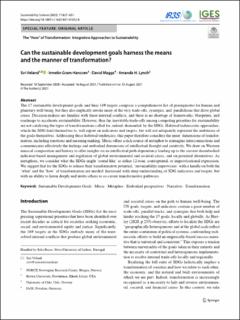| dc.description.abstract | The 17 sustainable development goals and their 169 targets comprise a comprehensive list of prerequisites for human and planetary well-being, but they also implicitly invoke many of the very trade-offs, synergies, and parallelisms that drive global crises. Decision-makers are familiar with these internal conflicts, and there is no shortage of frameworks, blueprints, and roadmaps to accelerate sustainability. However, thus far, inevitable trade-offs among competing priorities for sustainability are not catalyzing the types of transformations called for, indeed, demanded, by the SDGs. Habitual technocratic approaches, which the SDG lend themselves to, will report on indicators and targets, but will not adequately represent the ambitions of the goals themselves. Addressing these habitual tendencies, this paper therefore considers the inner dimensions of transformation, including emotions and meaning-making. Music offers a rich source of metaphor to reimagine interconnections and communicates affectively the feelings and embodied dimensions of intellectual thought and creativity. We draw on Western musical composition and history to offer insights on an intellectual path-dependency leading up to the current disembodied indicator-based management and regulation of global environmental and societal crises, and on potential alternatives. As metaphors, we consider what the SDGs might ‘sound like’ as either 12-tone, contrapuntal, or improvisational expression. We suggest that for the SDGs to release their transformative potential, ‘sustainability improvisers’ with a handle on both the ‘what’ and the ‘how’ of transformation are needed: harnessed with deep understanding of SDG indicators and targets, but with an ability to listen deeply and invite others to co-create transformative pathways. | en_US |

